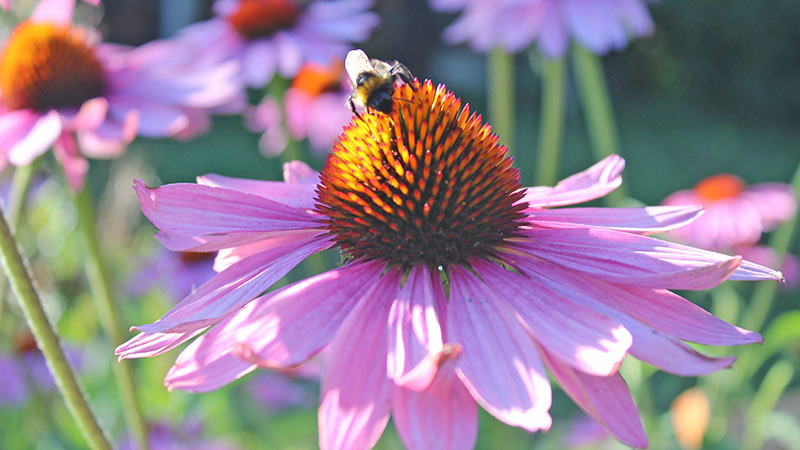Mason bees are your shiny, metallic garden friends

By Sheilab Cubick
OSU Ext. master gardener volunteer
What is the image you see when someone says the word bee?
Do you picture the black and yellow striped body of the honeybee? That’s what I see in my mind’s eye.
But not all bees have the distinctive coloring or colonized behavior of the honeybee.
Mason bees (Osmia spp.) have shiny blue or green (or occasionally black or brown) bodies with a moderate number of hairs. They are sometimes mistaken for flies because of their bright shiny coloring. They are in the taxonomical family Megachilidae meaning “big-lipped family” which describes the large mouth-parts which these solitary bees use to shape their nesting cavities.
Female mason bees prefer to make their nests in existing cavities. These are usually beetle burrows in wood, perennial plant stalks, rocks or abandoned ground-nesting bee burrows, but will sometimes construct nests out of rocks that they fasten together with mud.
They place an egg at the end of the tunnel then place a ball of pollen and nectar next to it for a food source for the larva. They seal these into their own little cell by gathering and spreading mud or sometimes chewed leaves into the opening.
Eggs placed in the back will develop into female bees and those placed in the front will become males.
They continue this process to the end of the cavity and seal the end.
These bees are very industrious – to create one egg cell requires a lot of work.
First she gathers mud by scraping it with her mouth and forming it into a ball, balances it between her mouth and legs to fly to the nest, begins shaping it into a wall and repeats this for several trips until she has enough mud to complete the wall.
Learn more
When: Oct. 15, 9:30 a.m.-noon.
What: Discover all the fun facts about mason bees, including their “mason-like” homes and pollination habits.
Cost: $15, includes refreshments, pastries and handouts.
Where: OSU Extension.
Details: Visit http://go.osu.edu/masonbees
Info: Call 330-533-5538.
Then she gathers pollen with the hairs on her abdomen, collects nectar in her nectar stomach and, back in the cell, regurgitates into the pollen to mix and forms it into a ball.
According to Wilson & Carril in “The Bees in Your Backyard,” it can take as many as 15 to 35 trips, visiting around 75 flowers each time, to gather enough pollen for just one cell.
Ohio’s 22 species of mason bees fly in the spring until August, completing their life cycle.
These bees are important for agriculture, since many specialize in gathering pollen from plants in the rose family, which includes many crops such as apples, cherries and plums.
So, welcome these visitors to your garden.
To learn more about these wonderful garden friends join us Oct. 15 for a program on mason bees at the OSU Extension Office, 490 S. Broad St., Canfield. Details can be found at http://go.osu.edu/masonbees.
To view the Common Bees and Wasps of Ohio Field Guide by the Ohio Department of Agriculture, visit http://go.osu.edu/commonbees.
 43
43
